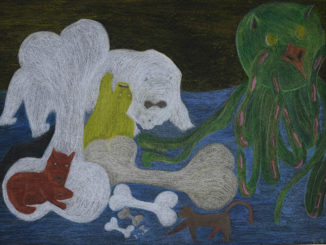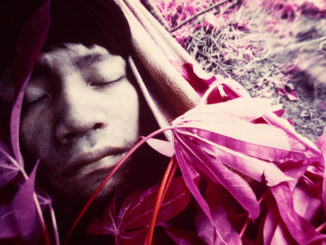
Darcy’s Law describes how a liquid disperses throughout a porous environment. The natural analogues are plenty: visualizations resemble everything from floodplains to capillaries to migration patterns. One could also talk about it in cultural terms, just replace water with cultural impetus, and sandy terrain with the equally shifting landscape of Miami.
Late at night on Sunday, October 23rd, the crowd was spilling out onto the sidewalk outside Tomorrowland, the project space run by artist George Sanches-Calderón. With characteristic nonchalance, Bhakti ter had kept details of his performance Darcy’s Law to a minimum. The back wall was illuminated by a projection of water and pennies on a plastic sheet. The projector was rigged with a small metal tube that the viewer could blow through, altering the arrangement of liquid and solid, and thus changing their projected specter. The resulting visualization looked like the combination of cell cultures and the set design of the 13th Floor Elevators.
The site of exhibition was shared with that of production. Bhakti stood at a table on the left of the garage, slopping ink onto a press and then squeezing off monotypes. These were handed to an assistant who thumb tacked them to the opposite wall. As the ink dried, guests were invited to pick their favorite off the wall on the condition that they signed the spot where it was. All this in a small garage hairy with Cohiba smoke.
The prints were uniform size, approximately 9 by 12 inches, on medium weight paper. Baxter produced the design by inking a fresh linoleum block and pressing it to the paper. Poignantly, the artist’s movements were indistinguishable – all differentiation was caused by the peculiarities of physics. The result was akin to Christopher Wool’s newest splotches. That is, the simplicity of the product relates directly to an opacity of method.
While the designs were similar, most looking somewhat like an algae bloom, the body of prints also revealed a startling amount of variety. Some displayed a harsh contrast between the areas that were inked and those where pockets of air had been trapped, while others provided a fine distribution between brown and white. Although the patterning was similar at both sides of the spectrum, the size of the design created radically different readings. The splotchier images resembled deer antlers on a wall, the smaller something closer to an ultrasound. To be sure, isolating hints of representation is not the way to read nonobjective work. But by isolating a physical phenomena at such a primary stage, Baxter’s prints locate a busy convergence of different natural processes, abstraction being just one among many.
Moreover, two fields of white space bracket each print. The resulting brown strip running through the prints referenced Rauschenberg’s early Automobile Tire Print, from 1951. It’s important to consider Darcy’s Law on the secondary planes of cultural and social diffusion. If the physical world can be reduced to formula, there must be a relationship between the other forces that govern our lives.
Tucked away in a corner is half answer. A slide projector offered a small, luminous photograph of a woman staring off into space. The photograph, which is of Baxter’s mother, was a happy accident – he only decided on including it during that afternoon’s installation. She sits at a table in Mexico (seaside, or carnival, somewhere from hardscrabble actualities) and is flanked by fast food containers – a wax paper soda cup and a Styrofoam clamshell. The photograph equally reveals distance and connection. In a Barthesian grasp towards the photographic past, we hold the image dear. Can one feel nostalgia towards food packaging? This is the effect of the photograph and the performance itself, to uncover latent and visceral connections between disparate worlds.



Be the first to comment